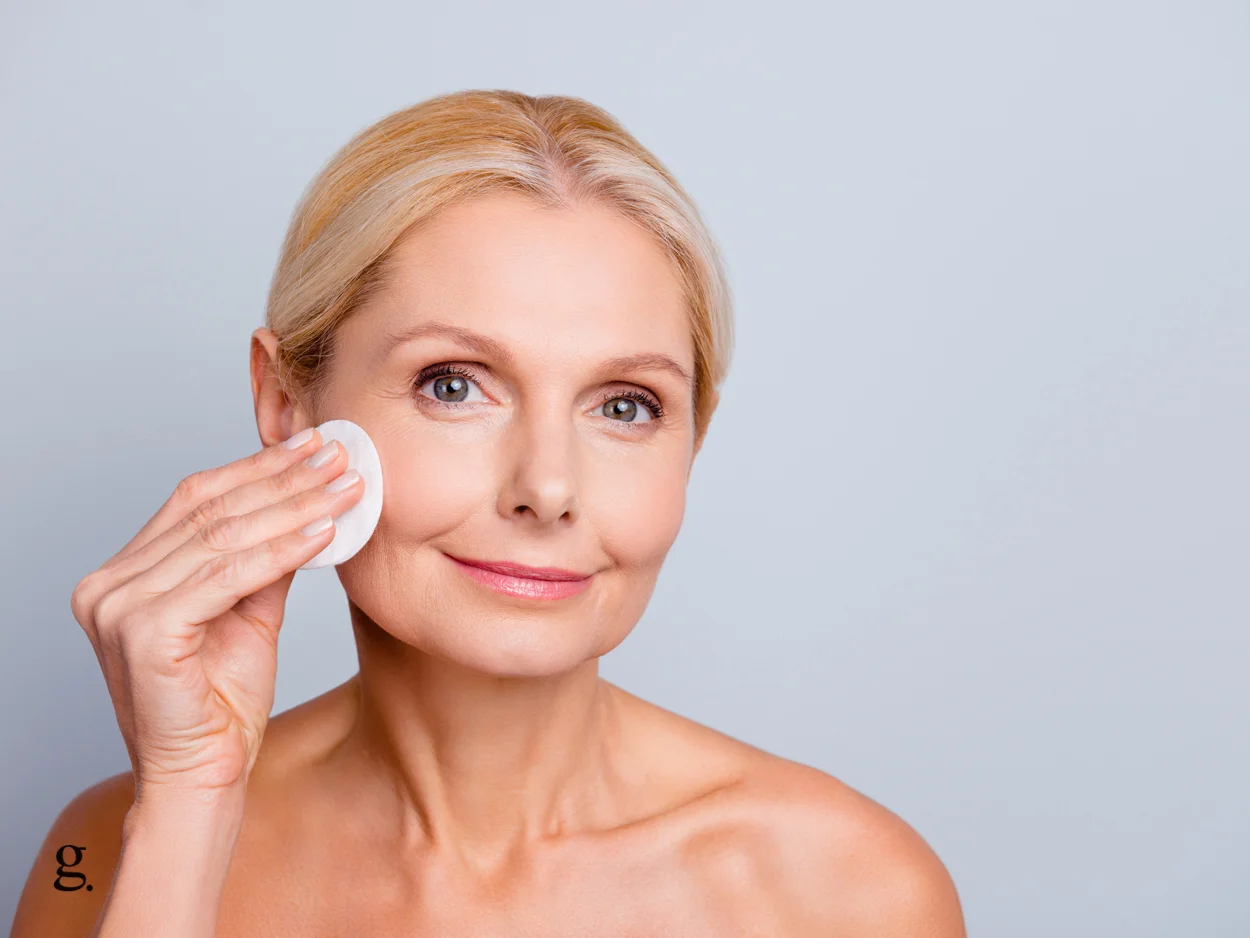When it comes to building a skincare routine, one size does not fit all, especially if your goal is anti-aging. Whether you’re preemptively trying to slow the early signs of aging, or already have aged skin and are trying to improve its appearance – you’ll need to plan things out in a little more detail to ensure you’re doing everything you can to achieve your goals.
This in-depth guide will walk you through everything you need to know about building your perfect skincare routine for anti-aging. For clarity’s sake, we recommend you implement this routine as your morning routine (except for the final step, which will be obvious when you get there).
Below, we’ve listed each step you’ll need to take, and what product(s) you’ll need for that step:
Step 1: Cleanser
Every single skincare routine, no matter what the end goal is, always starts with cleansing, so you’re going to need to get your hands on one!
A cleanser is a skincare product specifically designed to remove dirt, oil, dead skin cells, and other impurities from your skin. It helps to unclog pores, prevent breakouts, and maintain overall skin health. Cleansers come in various forms, but the most popular are gels and foams.
Not all cleanser products are made equal, however; you’re doing to want to get one with good active ingredients.
Some of the best ingredients to keep an eye out for include:
- Glycolic Acid (AHA): A gentle exfoliating agent that helps remove dead skin cells, revealing a smoother and more radiant complexion.
- Salicylic Acid (BHA): An excellent ingredient for those with acne-prone or oily skin, as it helps unclog pores, reduce inflammation, and prevent breakouts.
For those with sensitive skin, it’s essential to tread carefully when selecting a cleanser containing acids. Opt for cleansers with lower concentrations of acids, around 0.5-1% maximum. Higher concentrations may irritate your skin or cause discomfort.
Always pay attention to your skin’s reactions and adjust your routine accordingly. It’s also a good idea to patch-test any new product before incorporating it into your routine to ensure it won’t cause any adverse reactions. Remember, gentle is the way to go when dealing with sensitive skin, so choose your cleanser wisely.
Step 2: Toner
The second step in your anti-aging skincare routine involves using a toner.
A toner is a liquid skincare product that’s applied directly after cleansing to help restore your skin’s pH balance, remove any leftover traces of dirt and makeup, and prep your skin for the next steps in your routine.
To use a toner, simply dampen a cotton pad with the product and gently swipe it across your face, avoiding the eye area. Alternatively, you can pour a small amount into your palms and gently pat it onto your skin.
Step 3: Antioxidant Serum
Now we get onto the actual anti-aging part of the routine! The third step of your anti-aging skincare routine is all about selecting the right antioxidant serum.
Antioxidant serums are powerhouse products that can help protect your skin from environmental stressors like pollution and free radicals, which can lead to premature aging.
Incorporating an antioxidant serum into your routine can help brighten your complexion, improve skin texture, and reduce the appearance of fine lines and wrinkles. Good antioxidant serums will contain some of the following active ingredients:
- Vitamin C: A potent antioxidant that can help brighten your skin, even out skin tone, and boost collagen production.
- Vitamin E: A nourishing antioxidant that helps protect and repair the skin while providing deep hydration.
- Ferulic Acid: A plant-based antioxidant that works synergistically with vitamins C and E, enhancing their protective and skin-repairing effects.
- Niacinamide: As mentioned earlier, niacinamide is a versatile ingredient that offers numerous benefits, including antioxidant protection and improved skin tone and texture.
To use an antioxidant serum, simply apply a few drops to clean, toned skin in the morning, gently massaging it in until fully absorbed. Follow with a moisturizer and sunscreen to lock in hydration and protect your skin from sun damage. With regular use, you’ll soon start to notice the rejuvenating effects of an antioxidant serum on your skin.
Step 4: Topical Retinol
The fourth step in your anti-aging skincare routine is retinol.
Retinol, a derivative of vitamin A, is a gold-standard ingredient in the world of anti-aging; it works by accelerating cell turnover, stimulating collagen production, and improving skin texture, resulting in smoother, firmer, and more youthful-looking skin.
You can either buy retinol on its own or in a product that features it.
When choosing a retinol product, it’s essential to consider your skin type and sensitivity. Retinol can cause irritation and dryness, especially when you first start using it. To minimize the risk of irritation, consider starting with a lower concentration of retinol (around 0.25%) and gradually increasing the strength as your skin becomes more accustomed to it.
Introduce retinol into your routine slowly, beginning with once or twice a week, and gradually increase the frequency as your skin tolerates it. Apply a pea-sized amount to clean, dry skin, avoiding the eye area.
Step 5: Moisturizer
The fifth step in your anti-aging skincare routine involves moisturizing.
Moisturizing is an essential step in any skincare routine, as it helps to maintain your skin’s hydration levels, strengthen its natural barrier, and keep it looking plump and youthful.
Moisturizers work by utilizing a combination of ingredients that help retain and replenish moisture in the skin. These ingredients typically fall into three main categories: humectants, emollients, and occlusives.
- Humectants: These ingredients attract and draw moisture from the air or the deeper layers of the skin to the outermost layer of the skin, known as the stratum corneum. Common humectants include hyaluronic acid, glycerin, and propylene glycol.
- Emollients: Emollients are responsible for filling in the gaps between skin cells, smoothing the skin’s surface, and improving its texture. They help maintain the skin’s softness, suppleness, and flexibility. Examples of emollients include fatty acids, ceramides, and oils like jojoba oil or squalane.
- Occlusives: These ingredients form a protective barrier on the skin’s surface, sealing in moisture and preventing water loss through evaporation. Occlusives are particularly beneficial in dry environments or when skin is exposed to harsh conditions. Examples of occlusives include petrolatum, beeswax, and lanolin.
A well-formulated moisturizer will often contain a blend of these three types of ingredients, working together to provide optimal hydration and protection for your skin
Choose a moisturizer that’s suited to your skin type—whether it’s a lightweight gel or a rich cream—to ensure that your skin gets the proper amount of hydration without feeling greasy or weighed down.
Step 6: Sunscreen
The sixth and final step in your anti-aging skincare routine is selecting the right sunscreen.
Sunscreen is crucial, as it protects your skin from the harmful effects of the sun’s ultraviolet (UV) rays, which can cause premature aging, hyperpigmentation, and other unwanted nasties.
There are two main types of sunscreens you could choose from: chemical and physical (also known as mineral) sunscreens.
- Chemical sunscreens contain organic compounds that absorb UV rays, converting them into heat before they can cause damage to the skin. Some common chemical sunscreen ingredients include avobenzone, oxybenzone, and octinoxate. These products tend to be lighter weight and absorb more easily into the skin, making them a preferred choice for many people, especially those looking for a sunscreen that won’t feel heavy on the skin.
- Physical (a.k.a mineral) sunscreens use ingredients like zinc oxide and titanium dioxide to create a barrier on the skin’s surface, reflecting and scattering UV rays. While physical sunscreens can be effective and are often recommended for sensitive skin, they can sometimes feel thicker and leave a noticeable white cast on the skin.
We personally recommend going for a chemical sunscreen, due to its lighter texture and ease of absorption. However, always choose a sunscreen that suits your skin type and personal preferences.
No matter the type you decide to use, make sure it has broad-spectrum protection, covering both UVA and UVB rays, with a minimum SPF of 30.
Step 7: Night Cream Before Bed
A good night cream can do wonders for your skin. While you sleep, your body is working to repair damage and regenerate new cells. Night creams are specifically formulated to work their magic while you sleep with nourishing and regenerative ingredients.
They often contain ingredients like hyaluronic acid and collagen, which help to hydrate and plump the skin. Night creams can also help to smooth fine lines and reduce the appearance of dark spots. By using a night cream before bed, you can give your skin a boost while you sleep, resulting in a more youthful and radiant complexion.
Other Things To Consider
Above we’ve given you a way of creating a rock-solid anti-aging skincare routine that’ll ensure you’re doing everything you can to fight against the visible signs of aging. In addition to your topical skincare routine, there are other things you can consider to support your skin’s health and fight the signs of aging from within.
Some of the most popular options include:
- Collagen Supplements: Collagen is a vital protein that makes up a significant portion of your skin’s structure. As we age, collagen production declines, leading to wrinkles and sagging skin. Collagen supplements, available in both capsule and drinkable form, can help boost your body’s collagen levels, potentially improving your skin’s elasticity and overall appearance.
- Daily Multivitamin: Taking a daily multivitamin can help ensure you’re getting all the essential nutrients needed to support skin health. Vitamins A, C, and E, along with minerals like zinc and selenium, play crucial roles in maintaining healthy skin. A daily multivitamin can help fill any nutritional gaps in your diet, further supporting your skin from the inside out.
- Bespoke Skin-Health Supplements: Personalized or bespoke skin-health supplements are designed to target specific skin concerns and needs, based on factors such as your age, skin type, and lifestyle. These supplements may contain a tailored blend of vitamins, minerals, and other ingredients known to support skin health and address your unique concerns.
Conclusion
Aging is an inevitable part of life, but the visible signs of aging can be mitigated with a comprehensive skincare routine tailored directly towards anti-aging.
To create an effective anti-aging routine, follow these steps: cleanse your skin with a gentle product, use a toner to balance pH levels, apply an antioxidant serum for protection against environmental stressors, incorporate retinol to promote cell turnover, moisturize to maintain hydration, protect your skin with a broad-spectrum sunscreen, and nourish your skin with a night cream.
In addition to these topical skincare products, consider supporting your skin’s health from within by taking collagen supplements, daily multivitamins, or bespoke skin-health supplements.
By following these guidelines, you can fight against the visible signs of aging and maintain a more youthful and radiant complexion.

